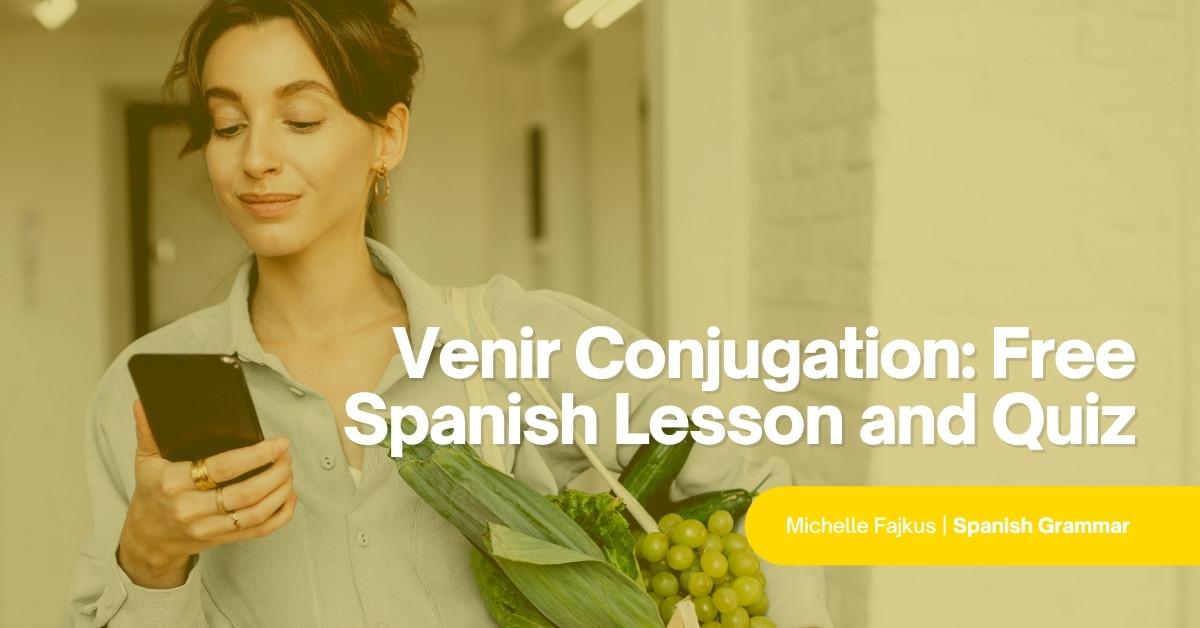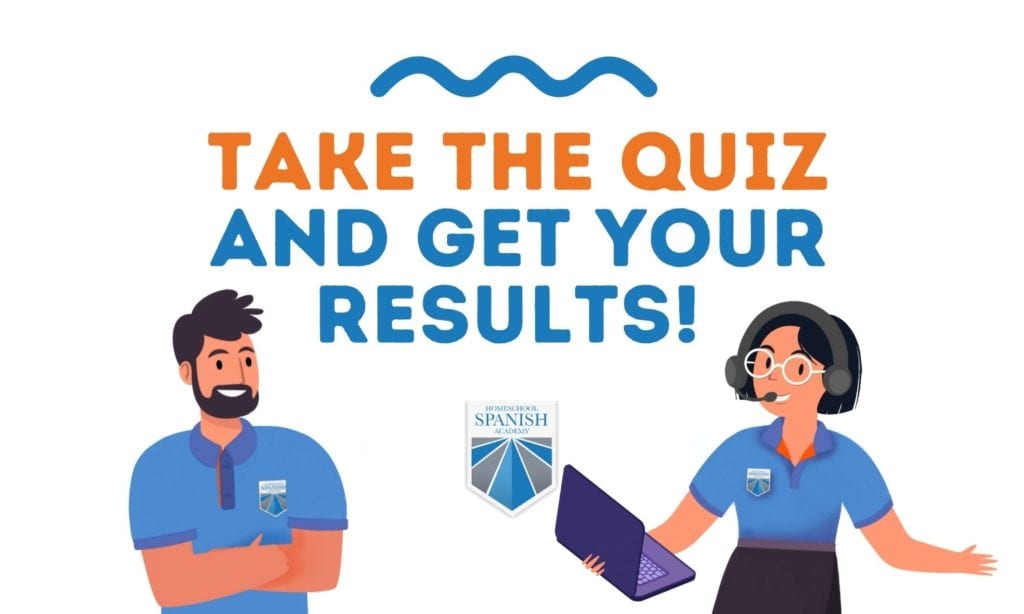
Venir Conjugation: Free Spanish Lesson and Quiz
If you’re a Spanish learner, you’ve come to the right place for a lesson on venir conjugation!
The Spanish verb venir means “to come.” Venir is an irregular, stem-changing -ir verb, similar to seguir.
Read this lesson to discover the ins and outs of venir conjugation in the following moods and tenses:
- Indicative mood (present, past, past imperfect, conditional, and future tense)
- Subjunctive mood (present, present perfect, past, and past perfect tense)
- Imperative mood (positive and negative commands)
¡Conjuguemos!
Let’s conjugate!
The Ultimate Guide to Venir Conjugation
Because this is a comprehensive guide to venir conjugation, you may not be familiar with all the tenses and forms shown. Fear not! Practice makes perfect, so keep at it, and soon you’ll be an expert at using Spanish verbs.
Test out your newfound venir conjugation skills with a multiple-choice quiz at the end of the post!
Hand-picked for you: Venir versus Llegar
Venir Conjugation – Verbals
For these Venir conjugations, there are two forms of the verb venir that you need to learn.
1. Conjugation of haber + past participle of venir
2. Conjugation of estar + gerund form of venir
Check out how to form past participles in Spanish and our ultimate guide to Spanish gerunds.
- The infinitive form of the verb is venir.
- The past participle of venir is venido.
- The gerund form of venir is viniendo.
These compound tenses involve using the helping verbs haber and estar. The conjugation changes in these tenses happen within the helping verbs, while the form of the verb venir stays the same.
Let’s see them in action!
¿Quieres venir conmigo?
Do you want to come with me?
Vanessa estará viniendo mañana.
Vanessa will be coming tomorrow.
Yo he venido a clase temprano hoy.
I have come to class early today.

Venir Conjugation – Indicative Mood
Now, let’s take a look at the venir conjugation in the indicative mood for present simple, past simple, past imperfect, conditional, and future simple.
Note that some example sentences do not have a pronoun. In these cases, the verb conjugation implies the subject.
1. Present Simple
The present tense of venir is the most common one. Notice the inclusion of the pronoun usted in the venir conjugation chart below. People in Spanish-speaking countries use it to replace the pronoun “you” as a sign of respect.
| Yo | vengo |
| Tú | vienes |
| Él, ella, usted | viene |
| Nosotros | venimos |
| Ellos, ellas, ustedes | vienen |
Example Sentences in Spanish
¡Vengo enseguida!
I’ll be right back!
Marco viene de compras con nosotras.
Marco is coming shopping with us.
¿Cuándo vienen a visitarnos?
When are they coming to visit us?
2. Past Simple
You will come across verbs in the pretérito (preterite) often. This is the simple past tense conjugation in Spanish.
| Yo | vine |
| Tú | viniste |
| Él, ella, usted | vino |
| Nosotros | vinimos |
| Ellos, ellas, ustedes | vinieron |
Example Sentences in Spanish
Vine porque necesitaba el dinero.
I came because I needed the money.
¿Para qué viniste?
What did you come for?
Nosotros vinimos a Guatemala la semana pasada.
We came to Guatemala last week.

3. Past Imperfect
The venir imperfect conjugation is ideal for describing something that used to happen continuously and repeatedly. It may refer to events that happened either sporadically or regularly.
| Yo | venía |
| Tú | venías |
| Él, ella, usted | venía |
| Nosotros | veníamos |
| Ellos, ellas, ustedes | venían |
Example Sentences in Spanish
Yo usualmente venía a este parque.
I used to come to this park often.
Venía cada día a nadar en la piscina.
I used to come to swim in the pool every day.
¿Leiste las instrucciones que venían con la licuadora?
Did you read the instructions that came with the blender?
4. Conditional
In the venir conditional form, the stem changes to vendr- and it translates to “would come.”
| Yo | vendría |
| Tú | vendrías |
| Él, ella, usted | vendría |
| Nosotros | vendríamos |
| Ellos, ellas, ustedes | vendrían |
Example Sentences in Spanish
Nosotros vendríamos aquí más si pudiéramos.
We would come here more if we could.
Yo vendría más seguido si tuviera más tiempo libre.
I would come here more often if I had more time to spare.
Ellos vendrían a casa si no tuvieran tanto trabajo.
They would come home if they didn’t have so much work.

5. Future Simple
Here, the stem of the venir conjugation again changes to vendr-. In the future tense, it translates to “will come.”
| Yo | vendré |
| Tú | vendrás |
| Él, ella, usted | vendrá |
| Nosotros | vendremos |
| Ellos, ellas, ustedes | vendrán |
Example Sentences in Spanish
Vendré sin falta a escucharles.
I will certainly come and listen.
¿A qué hora vendrás a la escuela mañana?
What time are you going to come to school tomorrow?
El Sr. García y su hija vendrán a comer con nosotros pasado mañana.
Mr. Garcia and his daughter will come for lunch with us the day after tomorrow.
Venir Conjugation – Subjunctive Mood
We use the subjunctive conjugation to talk about hypotheses, hopes, wishes, or uncertainty. This is a more advanced mode of the Spanish verb venir.
The forms of this mood are the present, past, past perfect, and future subjunctive. The future subjunctive tense exists but is rarely used, so I’m not including it in this lesson.
1. Present Subjunctive
The present Spanish subjunctive expresses ideas, thoughts, desires, possibilities, and doubts.
| Yo | venga |
| Tú | vengas |
| Él, ella, usted | venga |
| Nosotros | vengamos |
| Ellos, ellas, ustedes | vengan |
Example Sentences in Spanish
Es posible que vengan.
It’s possible that they will come over.
Paramos porque puede ser que venga otro carro.
We stopped because there may be a car coming.
Nosotros comeremos en cuanto venga mi papá.
We will eat when my dad comes.
2. Past Subjunctive
Here is the Spanish past subjunctive. In this venir conjugation chart, you have two endings, -iera and -iese. While both are correct, the latter is more antiquated and formal.
| Yo | viniera o viniese |
| Tú | vinieras o vinieses |
| Él, ella, usted | viniera o viniese |
| Nosotros | viniéramos o viniésemos |
| Ellos, ellas, ustedes | vinieran o viniesen |
Example Sentences in Spanish
Yo no creía que Andrea viniera.
I didn’t think Andrea would come.
¡Ojalá Pablo viniera en diciembre!
I wish Pablo would come in December!
Mi tía me dijo que viniera para la cena.
My aunt told me to come for dinner.

3. Past Perfect Subjunctive
The past perfect subjunctive is an advanced verb form also known as el pluscuamperfecto del subjuntivo (the pluperfect subjunctive). We use it to explain past hypothetical situations that precede hypothetical outcomes.
Notice how in this venir conjugation chart you have two choices, hubiera and hubiese. You can use them in any context, but keep in mind that the latter is more formal.
For the past perfect subjunctive tense, we use the auxiliary verb haber and the past participle of venir.
| Yo | hubiera o hubiese + venido |
| Tú | hubieras o hubieses + venido |
| Él, ella, usted | hubiera o hubiese + venido |
| Nosotros | hubiéramos o hubiésemos + venido |
| Ellos, ellas, ustedes | hubieran o hubiesen + venido |
Example Sentences in Spanish
La maestra dijo que ella esperaba que yo hubiera venido a la clase temprano.
The teacher said that she was hoping that I had come to class early.
Si hubieras venido a la boda, te lo hubieras pasado bien.
If you had come to the wedding, you would have had a good time.
4. Present Perfect Subjunctive
The present perfect subjunctive or pretérito perfecto del subjuntivo expresses connections between past actions and the present.
| Yo | haya + venido |
| Tú | haya + venido |
| Él, ella, usted | haya + venido |
| Nosotros | haya + venido |
| Ellos, ellas, ustedes | haya + venido |
For the perfect subjunctive tense we use the auxiliary verb haber and the past participle of venir.
Example Sentences in Spanish
¿No te alegras de que él haya venido a la reunión?
Aren’t you glad that he came to the meeting?
Están felices de que Simón haya venido a cenar.
They like that Simon has come for dinner.
Me sorprendo de que hayas venido.
I am surprised that you have come.
Venir Conjugation – Imperative Mood
We use the imperative mood to give commands. The imperative mood emphasizes the verb, as the sentence normally starts with it unless it is a negative form.
| Affirmative | Negative |
| ¡Venga! | ¡No venga! |
| ¡Vengas! | ¡No vengas! |
| ¡Vengamos! | ¡No vengamos! |
| ¡Vengan! | ¡No vengan! |
Example Sentences in Spanish
Pues, venga, ¡ánimo!
Well, come on, let’s do it!
¡No vengamos!
Let’s not come!
Venir Conjugation Quiz

Check your understanding of venir conjugation with the following exercises! Be sure to check your answers using the answer key at the bottom of the post.
1. Choose the mood that corresponds to this sentence: Nosotros vinimos ayer (We came yesterday.)
2. What are the participle and gerund forms of the verb venir?
3. Select the correct venir conjugation of the past simple: Ayer usted ________ a la clase a tiempo. (Yesterday you came to class on time.)
4. Conjugate venir for ellos in the conditional indicative.
5. Which of these is the informal affirmative “you” command?
6. Translate the following sentence into English: Vengo a recoger mi cheque de pago.
7. Translate the following sentence into Spanish: Juana has come to work today.
8. Fill in the blank with a past perfect subjunctive tense conjugation: Ojalá que tú ________ a tiempo. (I wish you had come on time.)
9. Identify the tense and pronoun of this venir conjugation: veníamos
10. Identify the tense and pronoun of this venir conjugation: vengan



Keep Practicing Your Spanish!
¡Buen trabajo! You have successfully learned the venir conjugation and many uses of this common Spanish verb. The best way to continue practicing this and other verbs is to take personalized lessons from our friendly, certified, native-speaking teachers at Homeschool Spanish Academy.
Did you know that you could earn anywhere from $50,000 to $125,000 extra by being fluent in a second language? In addition to opening the door to new experiences and accessing an amazing lifelong tool, you could up your income by boosting your Spanish proficiency!
To take your Spanish to the next level by engaging in real-life conversations, sign up for a free trial class today!

Ready to learn more Spanish grammar? Check these out!
- 50 Useful Spanish Transition Words for Everyday Speech and Writing
- Master the 18 Spanish Tenses (and Take Our Cheat Sheet With You)
- All About Adverbial Clauses in Spanish
- The Ultimate Guide to the Differences Between ‘Pero’ and ‘Sino’ in Spanish
- A Guide to Double Negatives in Spanish
- Ver Conjugation: Free Spanish Lesson, Exercises, and PDF
- Common Irregular Informal Commands in Spanish
- Dialect vs Accent: Is It a Language, Dialect, or Accent?
- Ver Conjugation: Free Spanish Lesson, Exercises, and PDF - December 5, 2024
- What Are the Different Levels of Language Proficiency? - October 17, 2024
- Master All the Forms of Ser in Spanish: Your Ultimate Grammar Guide - July 18, 2024




